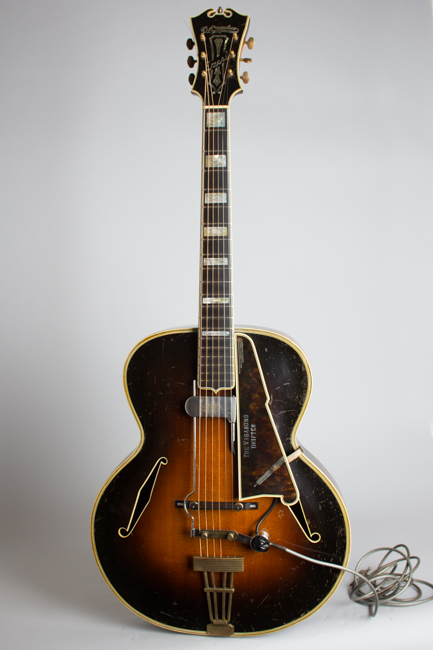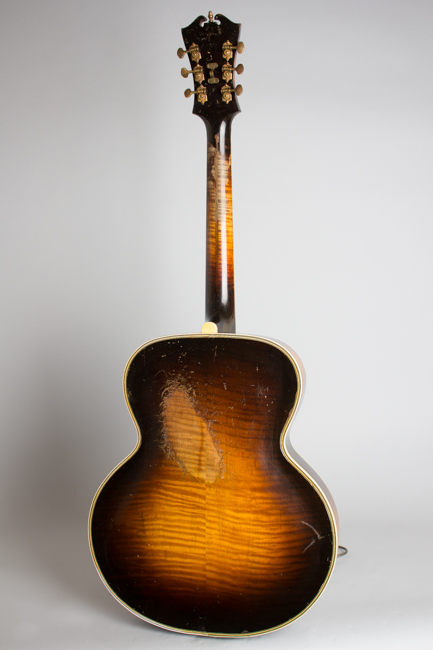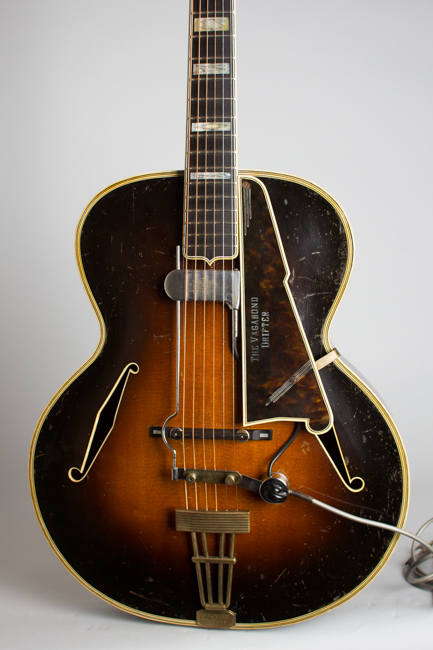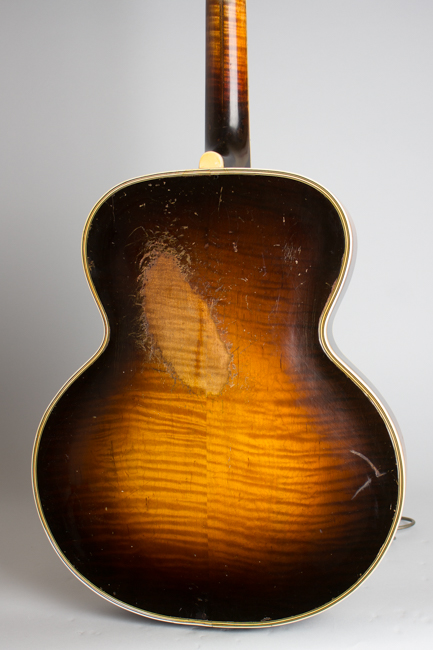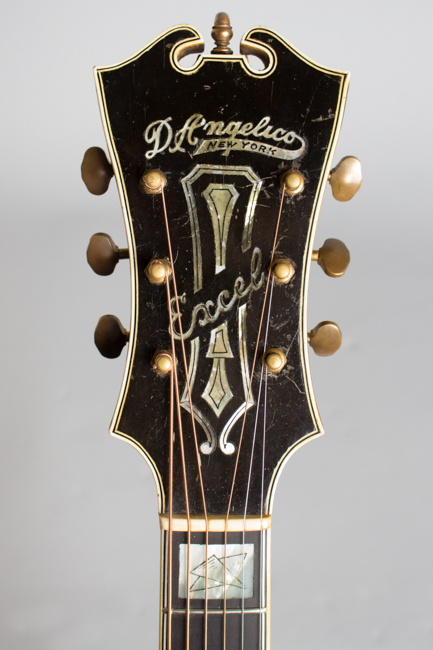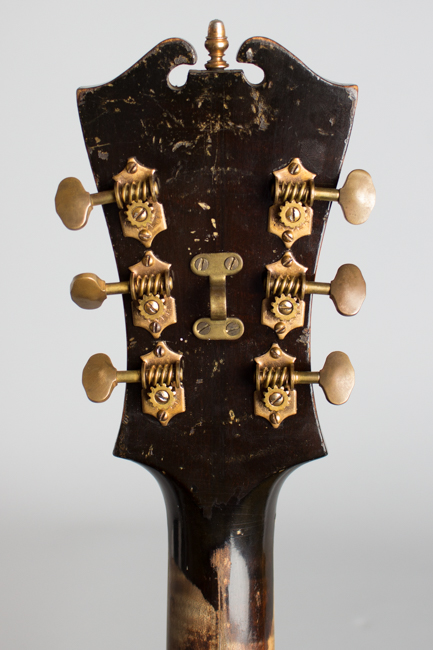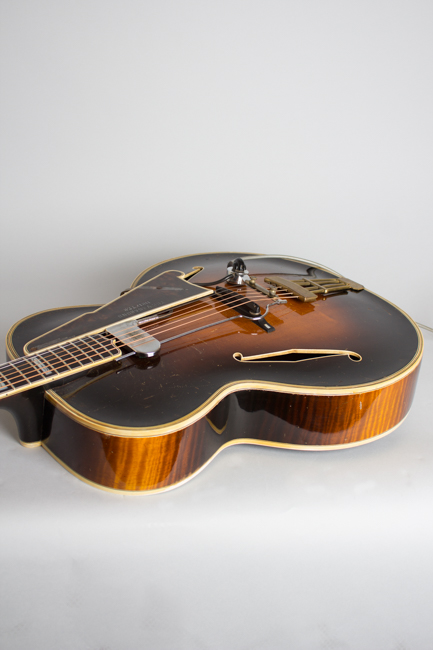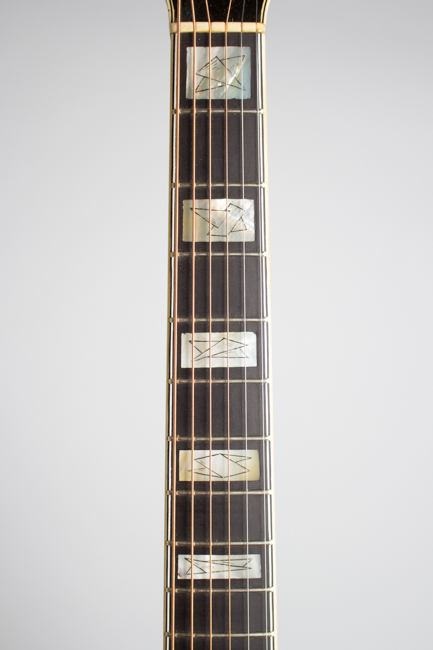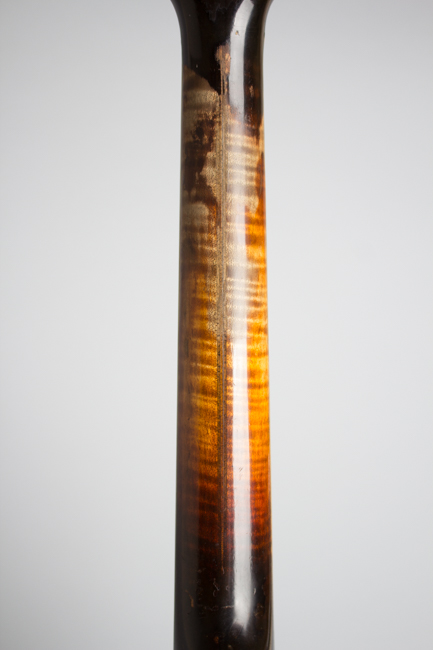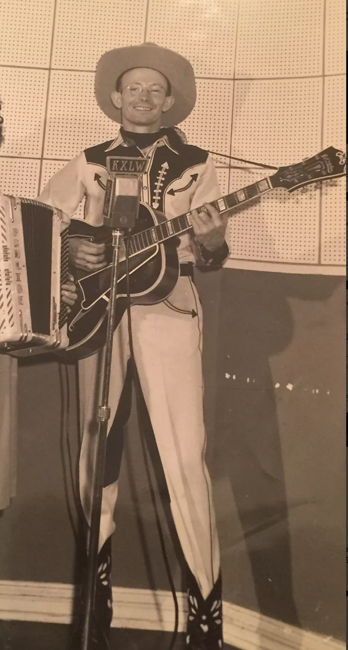D'Angelico Excel Arch Top Acoustic Guitar (1937)
This item has been sold.
Item # 7740
Prices subject to change without notice.
D'Angelico Excel Model Arch Top Acoustic Guitar (1937), made in New York City, sunburst lacquer finish, maple back and sides, spruce top; laminated maple neck with ebony fingerboard, period black hard shell case.
A man walks into a guitar store…it sounds like the opening of a joke, but in this case it was the beginning of a story. Sometime in late 1937 a customer named Eddie Wilson came to Gravois Music at 4650 Gravois Avenue in St. Louis, one of the city's leading musical emporiums. He left with this guitar, an Excel model made back east in New York by John D'Angelico, then just gaining a national reputation as a builder of the finest carved top guitars.
Whether the guitar had been specially ordered or the customer just took a fancy to it we may never know, but either before or soon after the purchase -- which would have been a major expenditure in the still-depressed St. Louis area -- block letters spelling out "The Vagabond Drifter" were very neatly engraved on the pickguard. This was Wilson's stage name as a radio entertainer, and in 1937 that career must have been going well enough that he could afford such a showy and expensive guitar.
At the time this guitar was bought, John D'Angelico was well into developing a signature style. His instruments, which at first closely resembled Gibson's L-5, began to take on their own distinctive character both in appearance and sound. The top-of-the-line Excel model began to appear in 1934-5 as D'Angelico took elements from Gibson and Epiphone and combined them into his own recipe for the perfect guitar. This late-1937 Excel has a 17" wide body (which Gibson had gone to in late 1935) and the name is spelled "EXCEL" in pearl script on the peghead; the earliest read "EXEL".
The guitar is extremely fancy even by the high-deco standards of the day. The top carries a beautiful dark sunburst finish and the newer-style streamlined bound f-holes typical of Excels from this year. The binding is a thick 7-ply on the top and back with a side linek, and there is triple binding on the top and side edges of the fingerboard. The fingerboard carries pearl block inlay with unusual engraved geometric patterns, again a feature unique to this period.
The headstock carries a typical "D'Angelico, New York" script logo over an elaborate pearl "Excel" surrounded by a large decorative motif. The headstock is triple bound with an early example of the famous signature brass finial at the crown. The back, sides, and five-piece laminated neck are of very heavily grained flame maple with a dramatic figure, the top of tight-grained spruce. The striking deco-style stairstepped pickguard has small decorative engravings around the mounting screws in addition to the personalization. The tuners and tailpiece are gold-plated and made by the Grover company of Long Island City; D'Angelico had not yet begun to have his own proprietary tailpieces made.
This guitar is listed in D'Angelico's ledger as completed and shipped to Gravois Music on 11/23/37 -- a less expensive Style A was sent out to them at the same time. The Gravois shop actually sold quite a few of D'Angelico's instruments; they seem to have been the largest single account outside New York on his books at the time. This may be related to someone teaching through the store at the time: one Mel Bay, who would continue to promote D'Angelico guitars through his school and extremely popular method books for decades hence.
Most of the guitars shipped to Gravois were the Style A -- the bottom of the line -- but in 1937 they ordered at least two Excels and in January 1938 one of the new super-fancy 18" New Yorkers. It's possible that this particular Excel was specially ordered for Eddie Wilson, but the shop may also have had it in stock when the "Vagabond" came in looking for the best guitar he could find. At least one other D'Angelico bought at Gravois (A style a S/N 1265) exists with the customer's name engraved on the pickguard.
This guitar shows signs of heavy use and must have served its original owner well. Although little useful information survives on "The Vagabond Drifter", at least one photograph clearly shows him at work broadcasting on the radio with this guitar, standing alongside an accordion player and cheerfully chording along in the key of Bb! There were many of these radio cowpokes in the 1930s and '40s; some are well-remembered today and many (especially if they never recorded commercially) are mostly forgotten.
This guitar appears to have been put away when his career waned; when we received the instrument it looked as if it had not been played in decades. It is now restored to perfect playability, still housed in the period Epiphone case it appears to have been in since new with the original dog-clip leather strap, a couple of old polishing cloths, used and unused strings, and sundry, including a pair of novelty pop-eyes that may have been part of his act! This is a fantastic package redolent with Americana, history, and centered around a fantastic sounding instrument built by one of the greatest guitar makers of the 20th century.
Overall length is 41 1/4 in. (104.8 cm.), 17 in. (43.2 cm.) wide at lower bout, and 3 1/4 in. (8.3 cm.) in depth, measured at side of rim. Scale length is 24 3/4 in. (629 mm.). Width of nut is 1 11/16 in. (43 mm.).
This beautiful instrument is a *very* well-played guitar; it served as a professional's working tool for a considerable period of time and was no doubt used continually. It is also -- and not coincidentally -- an exceptionally fine-sounding guitar, even by early D'Angelico standards. There is general finish wear to the entire surface of the instrument in the form of scratches, scrapes, and dings, but only two large areas of worn through lacquer.
The largest is on the back, where the Drifter's probably large and ornate belt buckle caused a sizable wear spot to the wood and also on the back of the neck, where the lower positions are worn through the lacquer from extensive play. Every piece of hardware is original including the bridge, tailpiece, tuners, specially engraved pickguard, and the first-generation c. 1940 DeArmond "Guitar mike" pickup currently mounted which looks to have been there since it was brand new.
This instrument has had some very careful restoration recently to bring it back to perfect playing condition. The original fingerboard had suffered at least one appalling re-fret, and has been painstakingly replaced with a new ebony piece using all the original engraved inlay and most of the original binding. The original worn and damaged ebony board will be included as a talisman, if desired!
Amazingly, the instrument has suffered very little in the way of cracks to the wood; only one very small tight grain split on the top in the middle of the upper bass bout. Even the top and back center seams, which often move as the wood shrinks and ages, have never opened up. The neck laminate seams can be felt in the lower positions as the wood has swelled slightly from long-term contact with the player's hand, but there are no open spots.
Apart from its history this is also just a very fine-playing and sounding guitar; the new frets are new period-correct wire, the board is perfectly true, and the neck has been very cleanly reset. Every step has been taken to preserve the instrument's well-played character and stay true to John D'Angelico's original creation. It sounds wonderful as a purely acoustic guitar and the DeArmond pickup (which is easily removable) still functions perfectly even after almost 80 years.
While we love a clean vintage piece as much as anyone, we also revere instruments like this that were a professional player's trusted tool for their livelihood. In the pantheon of great entertainers the Vagabond Drifter may have faded away but the guitar still survives proudly, a testament to its justly revered maker and perhaps sadly forgotten owner. Overall Very Good + Condition.
A man walks into a guitar store…it sounds like the opening of a joke, but in this case it was the beginning of a story. Sometime in late 1937 a customer named Eddie Wilson came to Gravois Music at 4650 Gravois Avenue in St. Louis, one of the city's leading musical emporiums. He left with this guitar, an Excel model made back east in New York by John D'Angelico, then just gaining a national reputation as a builder of the finest carved top guitars.
Whether the guitar had been specially ordered or the customer just took a fancy to it we may never know, but either before or soon after the purchase -- which would have been a major expenditure in the still-depressed St. Louis area -- block letters spelling out "The Vagabond Drifter" were very neatly engraved on the pickguard. This was Wilson's stage name as a radio entertainer, and in 1937 that career must have been going well enough that he could afford such a showy and expensive guitar.
At the time this guitar was bought, John D'Angelico was well into developing a signature style. His instruments, which at first closely resembled Gibson's L-5, began to take on their own distinctive character both in appearance and sound. The top-of-the-line Excel model began to appear in 1934-5 as D'Angelico took elements from Gibson and Epiphone and combined them into his own recipe for the perfect guitar. This late-1937 Excel has a 17" wide body (which Gibson had gone to in late 1935) and the name is spelled "EXCEL" in pearl script on the peghead; the earliest read "EXEL".
The guitar is extremely fancy even by the high-deco standards of the day. The top carries a beautiful dark sunburst finish and the newer-style streamlined bound f-holes typical of Excels from this year. The binding is a thick 7-ply on the top and back with a side linek, and there is triple binding on the top and side edges of the fingerboard. The fingerboard carries pearl block inlay with unusual engraved geometric patterns, again a feature unique to this period.
The headstock carries a typical "D'Angelico, New York" script logo over an elaborate pearl "Excel" surrounded by a large decorative motif. The headstock is triple bound with an early example of the famous signature brass finial at the crown. The back, sides, and five-piece laminated neck are of very heavily grained flame maple with a dramatic figure, the top of tight-grained spruce. The striking deco-style stairstepped pickguard has small decorative engravings around the mounting screws in addition to the personalization. The tuners and tailpiece are gold-plated and made by the Grover company of Long Island City; D'Angelico had not yet begun to have his own proprietary tailpieces made.
This guitar is listed in D'Angelico's ledger as completed and shipped to Gravois Music on 11/23/37 -- a less expensive Style A was sent out to them at the same time. The Gravois shop actually sold quite a few of D'Angelico's instruments; they seem to have been the largest single account outside New York on his books at the time. This may be related to someone teaching through the store at the time: one Mel Bay, who would continue to promote D'Angelico guitars through his school and extremely popular method books for decades hence.
Most of the guitars shipped to Gravois were the Style A -- the bottom of the line -- but in 1937 they ordered at least two Excels and in January 1938 one of the new super-fancy 18" New Yorkers. It's possible that this particular Excel was specially ordered for Eddie Wilson, but the shop may also have had it in stock when the "Vagabond" came in looking for the best guitar he could find. At least one other D'Angelico bought at Gravois (A style a S/N 1265) exists with the customer's name engraved on the pickguard.
This guitar shows signs of heavy use and must have served its original owner well. Although little useful information survives on "The Vagabond Drifter", at least one photograph clearly shows him at work broadcasting on the radio with this guitar, standing alongside an accordion player and cheerfully chording along in the key of Bb! There were many of these radio cowpokes in the 1930s and '40s; some are well-remembered today and many (especially if they never recorded commercially) are mostly forgotten.
This guitar appears to have been put away when his career waned; when we received the instrument it looked as if it had not been played in decades. It is now restored to perfect playability, still housed in the period Epiphone case it appears to have been in since new with the original dog-clip leather strap, a couple of old polishing cloths, used and unused strings, and sundry, including a pair of novelty pop-eyes that may have been part of his act! This is a fantastic package redolent with Americana, history, and centered around a fantastic sounding instrument built by one of the greatest guitar makers of the 20th century.
Overall length is 41 1/4 in. (104.8 cm.), 17 in. (43.2 cm.) wide at lower bout, and 3 1/4 in. (8.3 cm.) in depth, measured at side of rim. Scale length is 24 3/4 in. (629 mm.). Width of nut is 1 11/16 in. (43 mm.).
This beautiful instrument is a *very* well-played guitar; it served as a professional's working tool for a considerable period of time and was no doubt used continually. It is also -- and not coincidentally -- an exceptionally fine-sounding guitar, even by early D'Angelico standards. There is general finish wear to the entire surface of the instrument in the form of scratches, scrapes, and dings, but only two large areas of worn through lacquer.
The largest is on the back, where the Drifter's probably large and ornate belt buckle caused a sizable wear spot to the wood and also on the back of the neck, where the lower positions are worn through the lacquer from extensive play. Every piece of hardware is original including the bridge, tailpiece, tuners, specially engraved pickguard, and the first-generation c. 1940 DeArmond "Guitar mike" pickup currently mounted which looks to have been there since it was brand new.
This instrument has had some very careful restoration recently to bring it back to perfect playing condition. The original fingerboard had suffered at least one appalling re-fret, and has been painstakingly replaced with a new ebony piece using all the original engraved inlay and most of the original binding. The original worn and damaged ebony board will be included as a talisman, if desired!
Amazingly, the instrument has suffered very little in the way of cracks to the wood; only one very small tight grain split on the top in the middle of the upper bass bout. Even the top and back center seams, which often move as the wood shrinks and ages, have never opened up. The neck laminate seams can be felt in the lower positions as the wood has swelled slightly from long-term contact with the player's hand, but there are no open spots.
Apart from its history this is also just a very fine-playing and sounding guitar; the new frets are new period-correct wire, the board is perfectly true, and the neck has been very cleanly reset. Every step has been taken to preserve the instrument's well-played character and stay true to John D'Angelico's original creation. It sounds wonderful as a purely acoustic guitar and the DeArmond pickup (which is easily removable) still functions perfectly even after almost 80 years.
While we love a clean vintage piece as much as anyone, we also revere instruments like this that were a professional player's trusted tool for their livelihood. In the pantheon of great entertainers the Vagabond Drifter may have faded away but the guitar still survives proudly, a testament to its justly revered maker and perhaps sadly forgotten owner. Overall Very Good + Condition.
